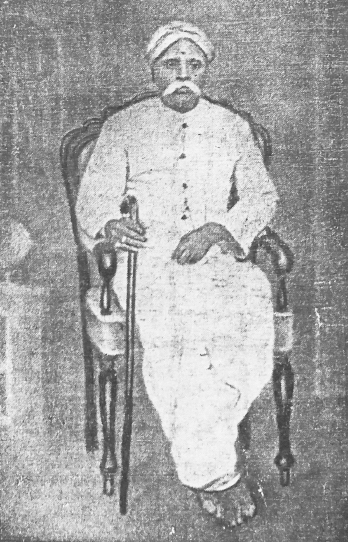Registered with the Registrar of Newspapers for India under R.N.I 53640/91
Vol. XXXIII No. 14, November 1-15, 2023
When Subramania Bharathi brought out an English magazine
-- by Karthik Bhatt
The national poet Subramania Bharathi’s avatar as an editor and journalist is well-documented. It is interesting to note that apart from his tryst with Tamil magazines such as the Swadesamitran, India, Chakravardhini, Karmayogi, Suryodayam and Vijaya, he also served as editor of a short-lived English monthly, the Bala Bharata. This is a brief profile of the magazine.
The periodical was funded by the well-known doctor and leading citizen of early 20th century Madras, Dr. M.C. Nanjunda Rao. Born in Nanjangud near Mysore in 1862, the doctor had moved to the city in the 1880s and after a stint in government service, setup flourishing private practice, where his clientele included several zamindars and nobility. He opened MCN Eclectic Dispensary for the poor in Triplicane where medicines were sold at highly subsidised rates. He was an important figure in the early days of the Ramakrishna Movement. An ardent devotee of Swami Vivekananda, he played host to the monk at his home in Mylapore, Sasi Vilas. It was at one of his other residences in Mylapore that the Ramakrishna Mission Students Home began its journey in 1905.
 Dr. M.C. Nanjunda Row.
Dr. M.C. Nanjunda Row.Nanjunda Rao was an ardent nationalist at heart. His standing as a doctor of repute and social spiritedness earned him the association and friendship of several prominent personalities of the freedom movement. For instance, Bipin Chandra Pal, considered one of the leading extremist leaders, during his visit to Madras delivered a series of lectures on the Bhagavad Gita at Sasi Vilas. Nanjunda Rao’s friendships with the likes of A.B. Kolhatkar of Nagpur and Neelakanta Brahmachari earned him a reputation of being a person with ‘strong views and great capacity for political intrigue’ in British Government records. He was one of Subramania Bharathi’s admirers and ardent supporters. When the controversy regarding Annie Besant’s proclamation of Jiddu Krishnamurthy as the world teacher and a book At the feet of my master purported to be written by him had broke out in 1911 with Nanjunda Rao leading the charge against the Theosophical Society, Bharathi who by that time had moved to Pondicherry wrote a satire titled The Fox with the Golden Tail, with the protagonist of the fable being modelled on Annie Besant. The work became a huge hit and it was at Nanjunda Rao’s insistence that a second edition was brought out by Subramania Bharathi in 1914.
Bala Bharata was founded at a time when there was intensepolitical activity in the country. The partition of Bengal in 1905 marked a pivotal moment in the freedom movement. Matters had come to a head in the Indian National Congress between the Moderates and the Extremists camps and the two were on the verge of a split. According to a pamphlet published just before the first issue, Bala Bharata’s objectives and presentation were to be the same as that of India, the Tamil magazine that was then being edited by Subramania Bharathi. It is not clear as to the circumstances which led to his appointment by Dr. Nanjunda Rao as the editor of this magazine as well. It was not Dr. Nanjunda Rao’s maiden experience at a literary venture. A few years earlier, at the insistence of Swami Vivekananda, he had been involved with the founding of the Brahmavadin and Prabuddha Bharata, two magazines connected with the Ramakrishna Order.
The first edition of Bala Bharata came out on Deepavali, November 4, 1907. It was published by Goodwin & Co, a pharmaceutical business that functioned out of Kutchery Road in Mylapore, which had also ventured in publishing. This was a business run by one of Dr. Nanjunda Rao’s closest friends, Dr. T. Govindaraja Pillai. One of Goodwin & Co’s best-known titles, a copy of which is available on the web was Annie Besant and the Alcyone Case, which came out in 1914 and was a complete account of the Jiddu Krishnamurthy custody case.

Bala Bharata came out as a monthly of 28 pages. A year’s subscription was priced at Re 1-8 annas. It was printed at the famous Guardian Press, run by G.C. Loganadham Bros. The magazine’s tagline was one of Swami Vivekananda’s most famous sayings, ‘Arise, Awake and Stop not till the goal is reached’. That Swami Vivekananda seems to have been the invisible driving force is borne by the fact that his speeches on various themes concerning the youth were featured prominently in every edition.Subramania Bharati was greatly inspired by Swami Vivekananda’s protégé Sister Nivedita and his interactions with her have been well documented. It is interesting to note here that besides Subramania Bharati, the Ramakrishna movement also greatly influenced two of his prominent colleagues, V.O. Chidambaram Pillai and Subramania Siva.
The former credits his meeting at the Ice House with Swami Ramakrishnananda, the monk sent by Swami Vivekananda to spread the Ramakrishna movement in South India as being instrumental in his involvement in the Swadeshi movement. Subramania Siva authored more than 10 books based on the life and teachings of Sri Ramakrishna and Swami Vivekananda.
Bala Bharata was described as a ‘monthly organ of Indian National Regeneration’. It reflected a genuine concern for national well-being and patriotic fervour ran through its various columns. Apart from extracts from other journals, there were original pieces written by writers such as C.V. Swaminatha Iyer of the Viveka Chintamani magazine and N.K. Swaminatha Iyer, eminent High Court Vakil from Tanjore and ardent Theosophist.
According to R.A. Padmanabhan, author of the Chitira Bharathi, there is unfortunately no record of how long the magazine came out. An educated guess would be that it ceased publication with Subramania Bharati’s escape to Pondicherry in 1908. Interestingly, according to a biographical sketch of Dr. Nanjunda Rao by his grandson G.K. Damodar Rao, the escape itself was facilitated by the nationalist doctor himself.


Comments